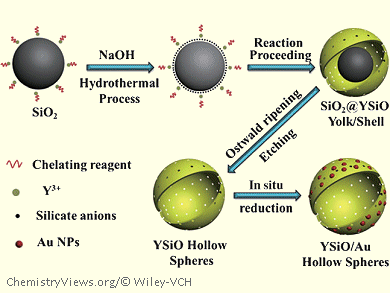Yan Xing, Northeast Normal University, Changchun, China, and colleagues have developed a synthetic strategy that uses SiO2 colloidal nanospheres as a sacrificial template to generate hollow rare-earth silicate spheres with mesoporous shells. The silica colloidal nanospheres were first dispersed into an alkaline solution containing yttrium nitrate hexahydrate, trisodium citrate dehydrate, and NaOH. Under hydrothermal conditions, the silica spheres dissolved to form silicate ions. The silicate ions reacted with Y3+ ions to form yttrium silicate (YSiO) particles in situ around the silica cores and, gradually, silica/YSiO yolk–shell structures were formed. Finally, the YSiO shells became dense and smooth. Thin, well-structured YSiO hollow spheres were thus obtained owing to Ostwald ripening at high temperature.
The YSiO hollow spheres had large specific surface area, high pore volume, and controllable structure parameters. The success of the synthesis depended on the selection of the chelating reagent to control the concentration of the free metal cations, which must be high enough to deposit with silicate ions, but not so high as to generate metal hydroxide.
The team hopes that this strategy can be extended as a general approach to prepare multifunctional yolk–shell structures with diverse compositions and morphologies simply by replacing the silica spheres with silica-coated nanocomposites.
- A General Route to Hollow Mesoporous Rare-Earth Silicate Nanospheres as a Catalyst Support,
Renxi Jin, Yang Yang, Yongcun Zou, Xianchun Liu, Yan Xing,
Chem. Eur. J. 2014.
DOI: 10.1002/chem.201303752




